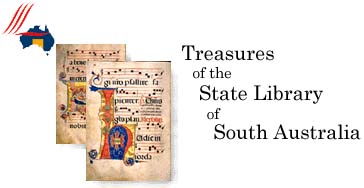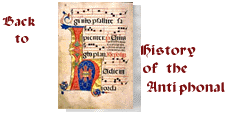
 |
|

The Friends of the State Library purchased the manuscript in 1945 at the
sale of the effects of Arthur Bryant Triggs(1868-1936)
of Yass, New South Wales. English born, the man who was to become
a wealthy grazier and antiquarian collector emigrated to Sydney
in 1887. He went first into banking, and his background in accounting
was put to profitable use when he turned to raising sheep and
cattle. His success had a beneficial effect on the general economy
of Yass, and he was generous to its societies and institutions.
In the Australian Dictionary of Biography he is described
as "very much the cultivated and courteous Englishman, beloved
by many for his quiet and genial nature." He had an informed
appreciation of literature and art, and on his visits to England
and Europe he collected medieval manuscripts, Bibles, incunabula,
autographs, Dickensiana, ancient coins, pictures and other objets
d'art, consulting staff at the British Museum for their
advice. When in London, Triggs frequented William Spencer's
bookshop, but we do not know as yet where he acquired the Antiphonal.
In 1938 his widow gave his collection of rare coins to the Nicholson
Museum of Antiquities at the University of Sydney. After her death
in 1945, the contents of their home were dispersed in a three-day
auction by J.R.Lawson, and at this point the Friends of the State Library of South Australia acquired
his 13th century Italian antiphonal for £77-10s-0d.
In modern currency this is equivalent to $3,227. It is now the
most valuable single item in the State Library's Rare Book Collection,
being unique and irreplaceable. If it appeared on the market today,
and such an event now happens extremely rarely, it would fetch
nearer $500,000.
The supposition that the Antiphonal was created in central Italy,
near Bologna, in the late 13th century, was based on the style
of the manuscript, particularly the illumination. Looking at the
example of the work of Nicolo da Bologna on the left-hand side
of this page, one can see how the our Antiphonal is very much
of that school.
We do not know from which monastery it originated, but now that
it has been studied we can indulge in some informed speculation.
Beneath the depiction of the Nativity on folio 5 verso, within
the illuminated and historiated letter H, is John the Baptist baptizing Christ,
who is shown as an infant although he was an adult when this occurred,
and on the right a saint is watching. The image of the saint has
become smeared from being kissed, suggesting that it was intended
to portray the patron saint. Initials containing scenes such as this appear in medieval manuscripts to highlight the subject of the work.
The illuminated letter S for Stephen which begins the first service
for December 26th, the feast of St Stephen the first martyr, is
elaborate. The wording of the services for the day, particularly
the text on folio 49 verso and 50 recto: "Yesterday our Lord
was born on earth so that Stephen might be born in Heaven,"
takes the point of his being the first martyr further and links
it directly with the birth of Christ. The saint's day on December
27 is that of John the Baptist, who is given two illuminated letters,
one large and one small, but on folio 74 verso there is the direction
to include the Proper for St Stephen in the service, with an antiphon.
Therefore it is possible that the patron saint attached to the
Nativity scene with John the Baptist is Stephen.
This emphasis on Stephen appeared during the transcription and
translation stage. Subsequently it was discovered that there is
a monastery of Santo Stephano in Bologna, which was flourishing
at the time this antiphonal was created. Perhaps our great book
was created there. We hope that more information will be forthcoming
as a result of making the manuscript more widely accessible. |

Copyright and this website | Disclaimer | Privacy | Feedback | Accessibility | Freedom of Information | Last update on 20 December 1997